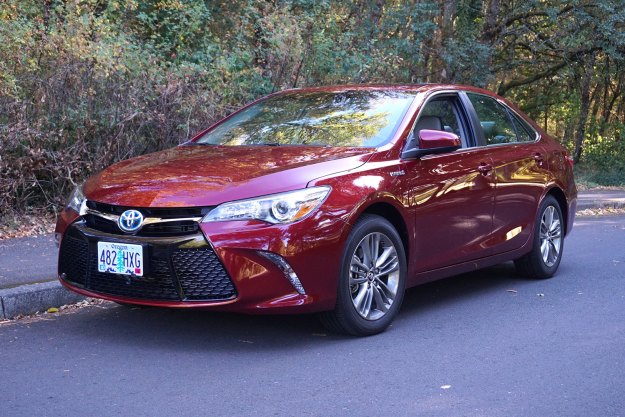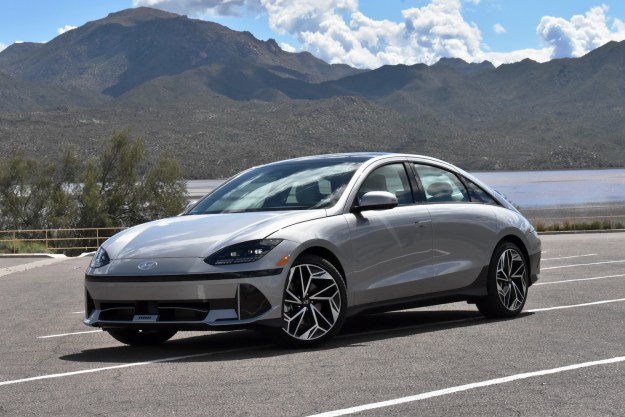
“The Toyota Camry does exactly what it promises to do: Move your family reliably and affordably, in comfort.”
- Good features for the price
- Toyota reliability
- Affordable hybrid option
- Comfortable and quiet
- Could be more exciting without sacrificing any value
What is it about the Toyota Camry that induces so many people to sign on the dotted line? Let us throw some number at you:
The Toyota Camry has been the best-selling passenger car in America every year since 2001. In 2015 Toyota sold 429,355 Camrys in the United States alone. In comparison, Volkswagen sold a total of 349,440 vehicles of all models. BMW and Mini sold 404,537 vehicles put together. The list goes on but you get the picture. When it comes to mid-size sedans, the Toyota Camry is by far the most popular choice. The second place Honda Accord sold 355,557 units in 2015, and the third place Nissan Altima came in at 333,398. The Ford Fusion sold 300,170, while Hyundai, Chevy, and Chrysler moved about 200,000 apiece of their mid-size offerings, so this market space of rather un-sexy cars is strikingly big business.
The short version? Simply put, it’s an attractive combination of functionality, reliability, features, and price. The mid-size sedan market is crowded, and competition is fierce. There are about 12-15 mid-size sedans to choose from every year, and if you want to sell, in volume you have to offer a very convincing all-around package. Toyota knows this, which is why the Camry reigns supreme in the segment.
A functional and reliable family car
The Toyota Camry’s top purpose is to move people around comfortably and efficiently. Let’s start with dimensions. The Camry seats five adults, and these can be real adults of normal size. Front headroom is generous at 38.8 inches, and the rear only slightly less at 38.1. You give up a little if you get the moonroof, but I’m an honest six feet tall and I have plenty of headroom with a moonroof model. Just as important, I can adjust the driver’s seat for myself, and then sit in the back and still have plenty of legroom.
The stats are: front legroom at 41.6 inches, and rear is 38.9 inches. Shoulder room is 58 inches in front and 56.6 inches in back. Both rows of seats offer 54.5 inches of hip room. Your total passenger cabin volume is 102.7 cubic feet, and you get 15.4 cubic feet of space in the trunk. I’m not sure what that works out to in terms of golf bags or standard grocery bags, but it’s a lot.
To make the same comparisons a mid-size sedan shopper would make, the Honda Accord is a little bigger in front seats, and a little smaller in the back seats. The Nissan Altima is a little bigger or smaller here and there, too. But we’re talking fractions of an inch difference between all the candidates on most measurements. What matters is that these cars will really transport a family of 5 under normal conditions with reasonable space.
The touchstone of the dependable family car is reliability, and that’s Toyota’s strong suit. By reputation and by the numbers, the Camry is about as reliable as it gets. Toyota doesn’t take risks with this car, so you’re going to get proven engines and drivetrains, and an overall design that Toyota’s been refining since the Camry debuted in 1982. The Camry consistently rates four to four-and-a-half points out of five in the J.D. Power Vehicle Dependability Study, and Toyota backs that with a standard five-year/60,000-mile powertrain warranty, plus two years/25,000 miles of free maintenance.
Gotta have the features
Mid-size sedans compete on features, and you can get pretty much anything you want on a Camry. In Toyota’s product information sheet, the list of features and different trim levels is five pages long. Let’s start in the cheap seats.
In 2015 Toyota sold 429,355 Camrys in the United States alone.
The absolute base model Camry LE offers air conditioning, backup camera, keyless entry, tilt-telescoping wheel, trip computer, cruise control, power everything, and holders for 10 cups and bottles.
The base stereo is an Entune multimedia unit with a 6.1-inch touch screen, voice recognition including Siri Eyes-free, Bluetooth hands-free phone support, and satellite radio. Remember, that’s all on the loss leader model, not the one you actually buy.
When you get up into the trim levels you want, you’re getting a moonroof, Qi wireless phone charging, push-button start, heated leather power-adjustable seats, and a JBL Audio stereo run through a 7-inch touchscreen with GPS navigation and full smartphone integration.
Because the Camry is first and foremost a family car, you also get every three-letter acronym safety device you can think of. Stability and traction controls, various braking controls, and autonomous emergency braking for collision mitigation are all standard. Things like blind spot monitoring, adaptive cruise control, lane departure, and rear cross-traffic alert show up as options in the upper trim levels.
But how does it drive?
Strangely enough, the “car’ part of the Camry is its least important aspect, but not because it’s a downside. It’s just not a priority. The Camry gives you decent performance, within the bounds of what Camry buyers want.
You have your choice of a 2.5-liter inline four-cylinder engine rated at 178 horsepower and 170 pound-feet of torque, or a 3.5-liter V6 that puts out a healthy 268 horsepower and 248 pound-feet of torque. Either way, the Camry always comes with a 6-speed automatic transmission and front wheel drive. The four-banger will get you 25 mpg city and 35 mpg highway, and the V6 returns 21 mpg city and 31 on the highway.
Because the Camry is first and foremost a family car, you also get every three-letter acronym safety device you can think of.
You can also get a Camry Hybrid, and the electric motors in combination with the four-cylinder engine are rated at a total output of 200 horsepower and 199 pound-feet of torque from 0-1500 RPM on the electric motors, and 156 pound-feet from the gas engine. Depending on the trim level, the Camry hybrid will get as high as 43 mpg in the city, and 39 on the highway. The Camry Hybrid uses an electronically controlled continuously variable transmission. Oh, and if you’re concerned about battery life, the hybrid system warranty is eight years/100,000 miles.
Out on the road, the Camry has remarkably nice manners. I’m sure some reviewers have complained about “numb steering” or less-than-crisp turn-in, but let’s be real. This is a car that you drive conservatively, and it does a good job at everything that you need a family car to do. If you have to make a panic stop, the brakes will do that and they won’t lock up. If you need to swerve to avoid a cat in the road, the Camry will do that, too, and you won’t lose control and crash. The Camry is perfectly predictable in all situations. And it’s quiet inside.
What’s it going to cost?
So, we’ve seen how the Camry fulfills the basic requirements for the high-volume mid-size sedan market, but the final hurdle before someone writes a check and signs the financing papers is the price. The most basic 2017 Camry is now starting at $23,935 including fees. That’s the highest base price in the segment. The low price leader is the Hyundai Sonata at $22,135, with most other brands priced in the low $23,000 range as a starting point. Chevrolet, Mazda, Kia, and Subaru all start in the $22,000 range. What this shows is that price isn’t everything. The above-mentioned features and Toyota’s reputation count for a lot.
Moving up the scale, even with options, you’d have a hard time finding a Camry with a sticker price much over $34,000. That includes the Hybrid, by the way. Base price on the 2017 Camry Hybrid is $27,655, and base price on the 2017 Camry V6 is $32,235. So, within a $10,000 price walk, you can take your pick from most of the nifty features available on the market today.
When you get down to it, the Toyota Camry maintains its dominance by being very good at doing what Toyota promises you the Camry will do: be comfortable and reliable transportation for you and your family. You’ll get a good value for your dollar in features and reliability, and the car will last a long time with low maintenance costs. That’s the very simple formula for selling nearly half a million cars a year.
Editors' Recommendations
- The 5 best car subscription services in 2024
- The Toyota Urban could be the low-cost electric crossover we’ve been waiting for
- Mercedes-AMG EQE SUV first drive review: a better electric SUV
- The locations of over 2 million Toyota cars were exposed for 10 years
- Mercedes-Benz EQE SUV first drive review: ’90s look, cutting-edge tech







